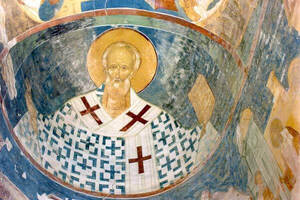From the Medieval Research Blog: "On St. Nick’s Beard"

The development of the appearance of the modern Santa Claus is a fascinating one, evolving from traditional representations in Germany and the Low Countries, a distinctly English Father Christmas, and the Coca-Cola Company’s efforts to sell product. One of the most distinctive features of the modern portrayal, though, predates all of these: the beard, a sine qua non of the modern depiction, dates back centuries, and likely originated with the historical St. Nicholas himself. Unlike some of the other aspects of his appearance, though, the decision of St. Nicholas (probably) to wear a beard, and the decisions of his later iconographers to depict him with one (or not, as the case may be), were generally not socially or theologically neutral. In this post, I’d like to explore some aspects of the meaning conveyed by St. Nick’s beard, focusing mostly on the Middle Ages and as an excuse to bring up my favorite research topic: the differences that arose between Latin and Greek expressions of Christianity during and after the conflict of the mid-eleventh century.
But first, by way of background, what can be said about the appearance of the historical St. Nicholas, the bishop of Myra in Asia Minor in the first half of the fourth century? While the sources for the general practice of the time period are not unanimous, the consensus of the Christian writers of the period, especially in the Eastern part of the Roman Empire, seems to have been in favor of beard-wearing [1]. Clement of Alexandria, writing the century prior, argued, “For God wished the woman to be hairless and smooth, rejoicing in her hair alone, like the horse does its mane, but He decorated man with a beard, just like the lions” [2]. Nor was the sentiment confined to Christian authors. Emperor Julian (“the Apostate” or “the Philosopher” depending on whom you ask), about as un-Christian an author as one could ask for and a reasonably close contemporary of Nicholas, is famous for his written defense of the beard. At the same time, clergy in many parts of the West, and the city of Rome in particular, retained the republican and imperial Roman custom of cleanshavenness.
The preference of the Eastern churchmen has been taken into account for forensic reconstructions done on the basis of the relics in his tomb in Bari, and the resulting depiction is dominated by a sizeable beard ]. This depiction persisted in subsequent centuries of Greek Christian iconography. From the earliest surviving example (seventh or eighth century, available in the Mount Sinai Archives), through to the present day, St. Nicholas, in the Greek tradition, is consistently depicted with a beard. And, given his ubiquity in the medieval and modern Orthodox church setting, it might be fair to say that he became one of the definitive archetypes for how clergy should look.
This is an excerpt from "On St. Nick’s Beard" by Dr. Nick Kamas. Read the full story.